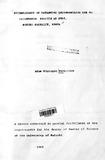| dc.description.abstract | A cross-sectional immunological. clinical and parasitological
investigation carried out on a sample population of 220 individuals
in a new focus of cutaneous leishmaniasis at Utut area. Rift Valley
Province in Kenya revealed a total positive leishmanin skin
reactivity rate of 29.0%. This was compared with a reactivity rate
of 23.4% in an adjacent area. Kongasis. The prevalence rates of
active lesions and scars were 19.4% and 6.5% respectively for Utut
and 3.7% and 6.9% respectively for Kongasis. The leishmanin test
reacti vity and clinical profile by age in the study area was
typical of a recent endemic focus of cutaneous leishmaniasis. and
depicted an age distribution disease pattern consistent with
people's habitation in tempdrary shelters and often in caves in
the Utut focus of cutaneous le~shmaniasis Males were more commonly infected than females:131.3% males and 26.7% females in
Utut. and 28.0% males and 18.9% females in Kongasis. Amastigotes
were detected in 4 (30.8%) of 13 patients found wi th cutaneous
lesions.
Four species of sandflies: Phlebotomus guggisbergi, P. saevus, P.
aculeatus and Sergentomyia schwetzi were distributed sympatrically
throughout the study area. Gut promastigotes which grew in Novyl.
MacNeal, Nicolle (NNN) culture were isolated from P. saevus. This
gave a parasite rate of 23.5%. A total parasite rate of 16.7% was
obtained in a sample of sandflies which included P. guggisbergi
and P. aculeatus in which no parasites were detected. The
distribution of previously proven vector P. guggisbergi and other
suspected vectors of the genus Phlebotomus suggest that cases of
cutaneous leishmaniasis may have contracted the disease from nearly
all the sites as people moved frequently in the Utut focus | en |

